The state of video conferencing 2022

Global SEO Manager

Data Analyst
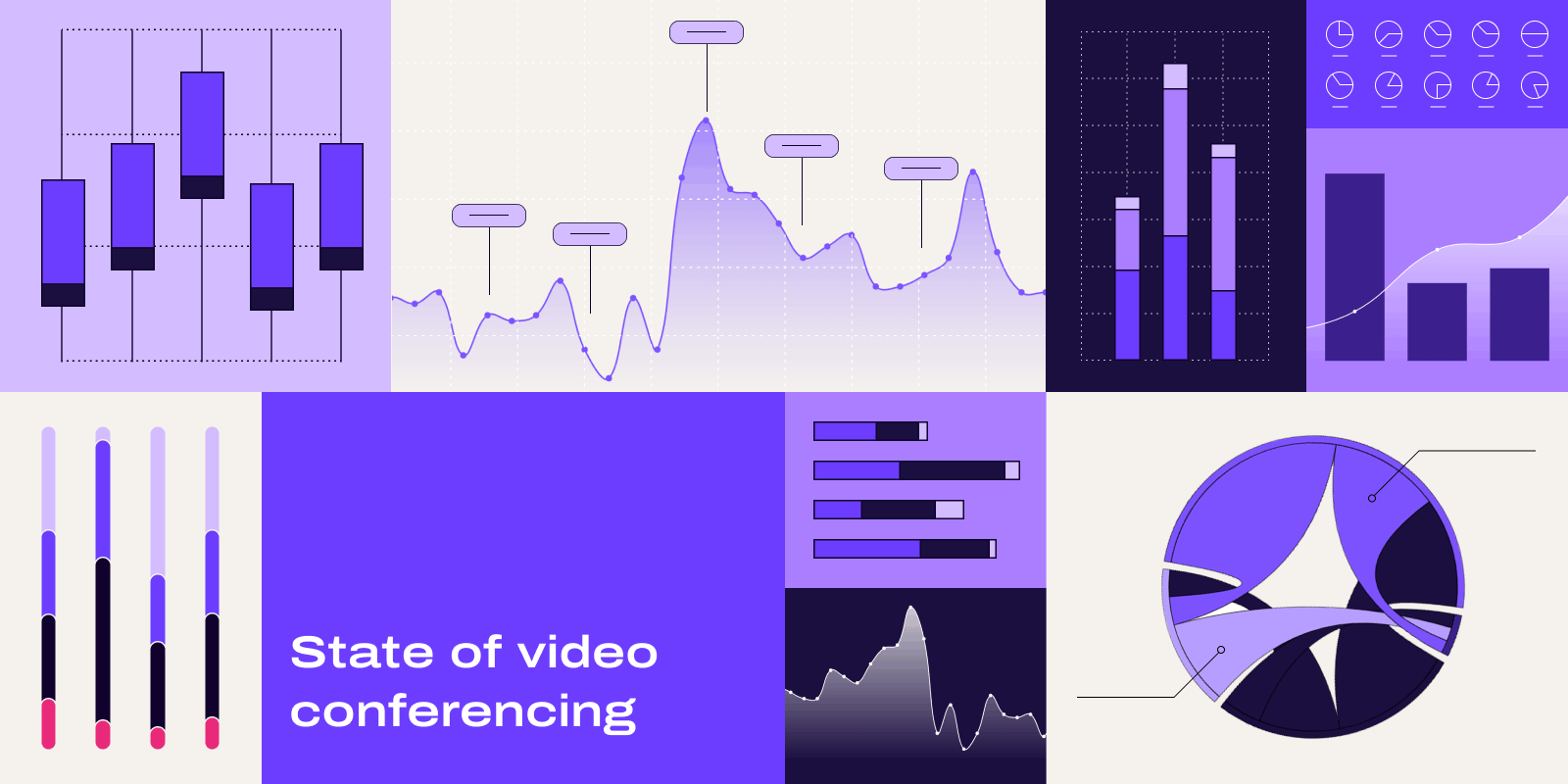
Tags
Share
2020 kicked off a dramatically increased need for video conferencing across all industries and businesses large and small. In 2021, that technology continued to grow not only in how much it’s used, but in what it can do.
Now here we are in 2022, and there’s no doubt that video conferencing is here to stay. That begs some key questions, like: what is the state of today’s video conferencing? How much time are we spending in meetings? And how can we make that time more productive?
To get a comprehensive overview, we did some research using two sources:
We surveyed over 2,800 U.S. employees from businesses of all sizes and across industries, and
Analyzed anonymized Dialpad Meetings data from the start of 2019 through June 2021 (see our Methodology section for more info).
With those, we gained insights into video usage, meeting times, and even the biggest pain points for video meetings. So join us as we take a look at the state of video conferencing in 2022.
Key Insights
A majority of people (83.13% of respondents) spend a third of the week, or less, in meetings.
75.6% prefer scheduling meetings on a certain day or time of day.
Mondays are the most popular day of week to schedule meetings, but Wednesdays have the longest meetings, on average.
“Too many meetings” isn’t the biggest pain point for video conferencing—audio-related issues are (over 50% of respondents).
82.9% believe not all video meetings require video.
One of the most time efficient meetings are stand-ups with 20 or less people. On average, they last 12-13 minutes.
What is video conferencing?
Video conferencing enables two or more people to meet via real-time video and audio communication. Although companies had invested in video conferencing systems since back in the 1990s, the widespread use and adoption of video conferencing skyrocketed in 2020. This report takes a closer look at this shift in the workplace.
How often do we meet?
Now, there’s no doubt that video conferencing shot up in frequency at the start of the COVID-19 pandemic, and we have the numbers to prove it. In March 2020, when the first work-from-home edicts began (indicated in the charts below with a dotted vertical line), folks using Dialpad organized an average of almost 12 meetings per person each month. However, by the middle of 2021, that averaged out to between nine and ten meetings—still quite a few, but not to the same frequency as before:
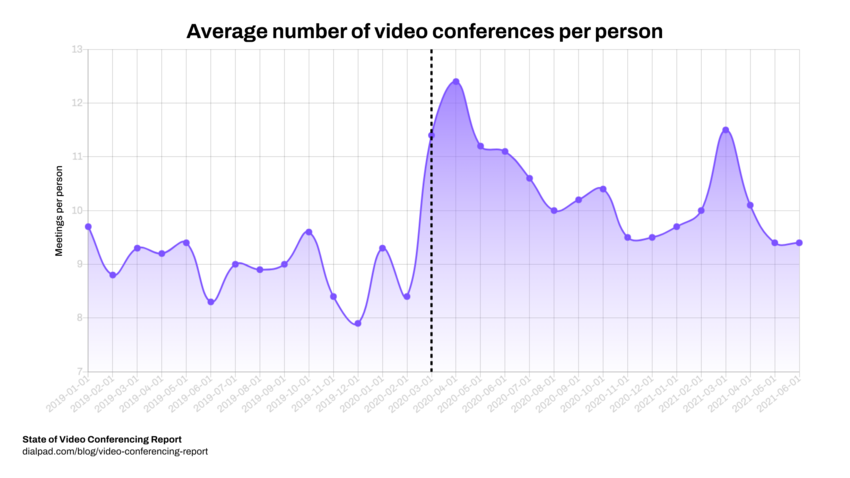
But that’s just an overall average—how does it vary by industry? When we look at the number of meetings for different industries, we can see some that have made video conferencing an integral part of their business model, while surprisingly, others that are leaving it behind as we slowly move past the pandemic.
The real estate industry has embraced the power of video conferencing. Considering how video conferencing enables virtual tours that can showcase houses to remote buyers, and connect realtors with buyers and sellers at a moment’s notice, this comes as no surprise that their use of video conferencing doubled after the pandemic.
Marketing & advertising industries have also experienced a steady increase in meetings but, unlike the overall average, did not spike when the pandemic began. Industries like health, media & telecommunications, and tech use video conferencing more heavily, and may have adapted their processes to rely more on video conferencing after the pandemic started.
On the other hand, the energy industry and professional services have decided that video conferencing isn't for them, with a high number of meetings before the pandemic and low number afterwards:
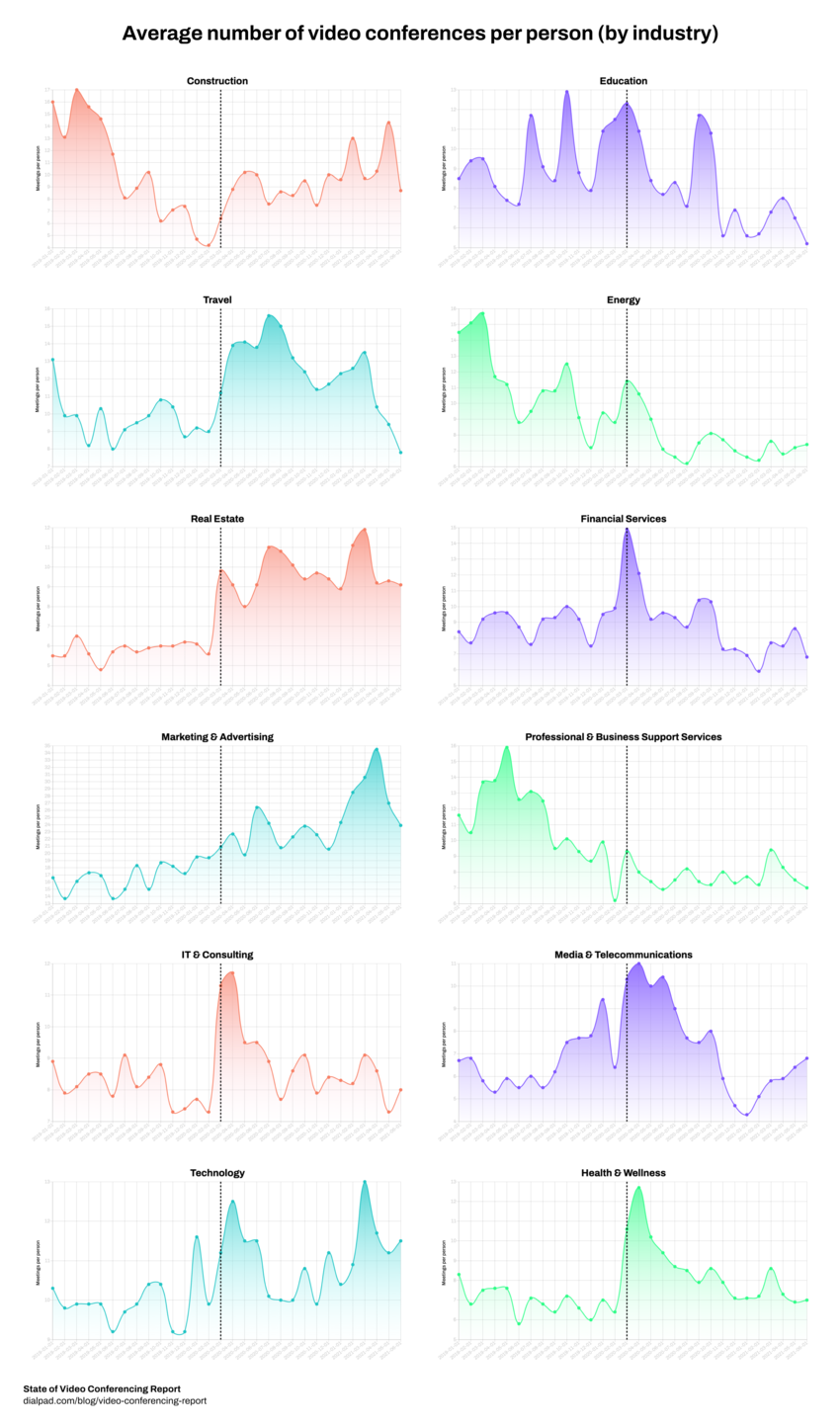
From our friends at Miro
Miro, a virtual whiteboarding tool that integrates with Dialpad, shared their philosophy on meetings with us:
"Our team has always relied on video conferencing as part of the collaboration process, even before the pandemic," said Pete Lim, an agile coach at Miro.
"To alleviate video fatigue and calendar overload, we try to be very intentional about meetings, ensuring that video conferencing is only used for discussions that carry a heavy emotional or cognitive load, or require a lot of back-and-forth discussion from participants."
Who has the most video conferences?
To answer this question, we analyzed the average number of video conferences held per month in each industry to determine who has the most meetings overall. As it turns out, the answer is—drumroll, please…
Marketing & advertising companies have the most video conferences, with an average of 20.9 meetings per person per month. That’s a lot of meetings!
That’s followed by companies in the travel industry with 11.1 meetings each month on average. And in third place, are tech companies, which have an average of 10.5 meetings per month.
Of course, the sizes of the businesses matter too. If we divvy them up based on size, we can see small and medium-sized businesses adopted video conferencing quickly, with an average of 8 to 10 meetings per person per month throughout 2020. It wasn’t until 2021 that larger businesses started relying more heavily on enterprise communication solutions like video conferencing, surpassing small and mid-market businesses starting in February 2021:
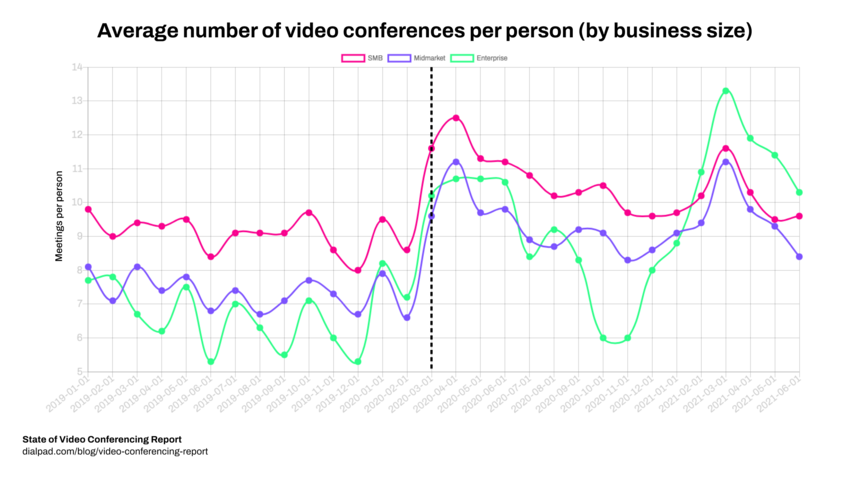
Overall, companies tended to follow the same trend: a sharp rise after the pandemic, followed by a slow trend downward, maybe as they began using more asynchronous communication to relieve video conferencing fatigue. However, we noticed the trends grew slightly different for larger companies.
At the high end of the mid-market segment, companies with between 751 and 1,000 people experienced a more steady trend down with fewer rises. Along the same lines, enterprise companies with 1,001 to 10,000 people started off rising, before dropping in Fall 2020 only to peak again in March 2021. Larger enterprises with more than 10,000 people had a delayed spike, peaking in May 2021:
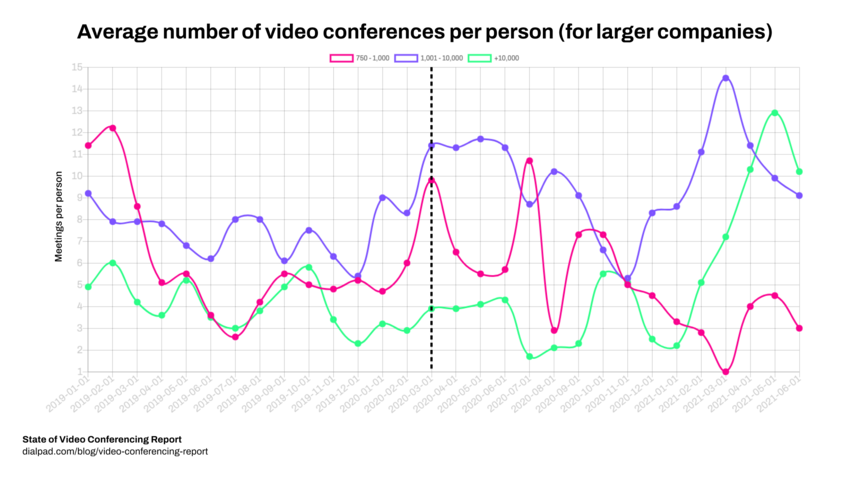
So what does this mean? Naturally, video conferencing isn’t a “one size fits all” solution, but their needs do vary based on industry, size, and changes in the pandemic. This speaks to the need for flexible solutions that come with a good conference call service, as it’s clear that video meetings are going to stick around in one capacity or another.
Want a PDF version of this report to read later?
Time spent in video conferences
Timing is everything. It may be a cliche to say, but it’s true, especially for meetings. So we have to ask: how often do people have video meetings, and when do they tend to take place?
Of those surveyed, 1,755 respondents said they have video conferences. 46.15% spend under four hours a week in video conferences, while 36.98% spend four to 12 hours. This means most people, 83.13%, spend 12 hours or less each week in meetings. On the other hand, there’s the 4.73% who spend more than half their week (that is, 20 hours or more)!

Of course, meetings don’t always take the same amount of time, so how often do they meet? Out of 2,821 U.S. employees, 37.82% meet one to two times a week, with 13% meeting three to five times, and another 12% meeting more than five times a week.
Yet even with the increased use of video meetings, there are still those who have never been in one at this point—a surprising 37% of respondents! (Do you think they know what they’re missing?)
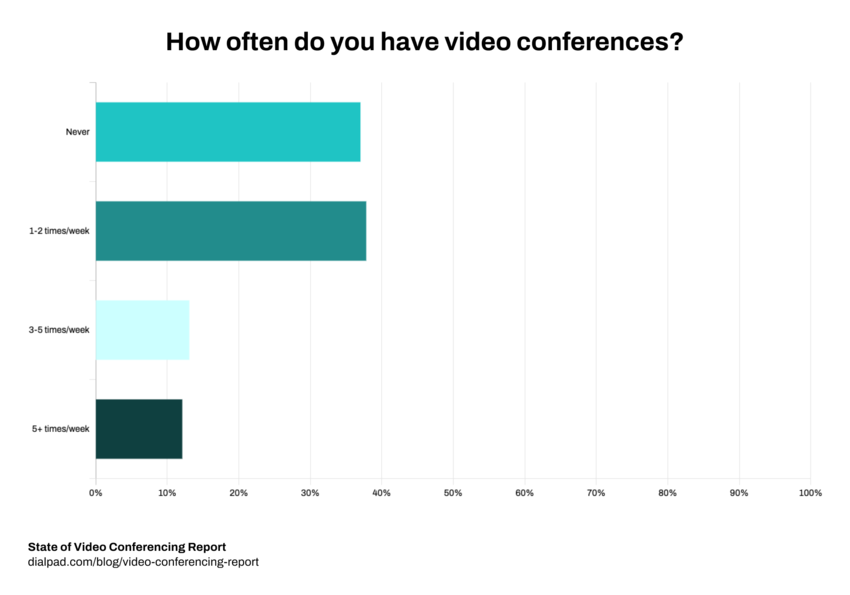
But just because some people can have five or more video meetings a week doesn’t mean that it’s a meeting a day. Everyone has different preferences for when they have video meetings. 75.61% of respondents prefer scheduling their meetings on certain days of the week or times during the day. Which day, you ask...
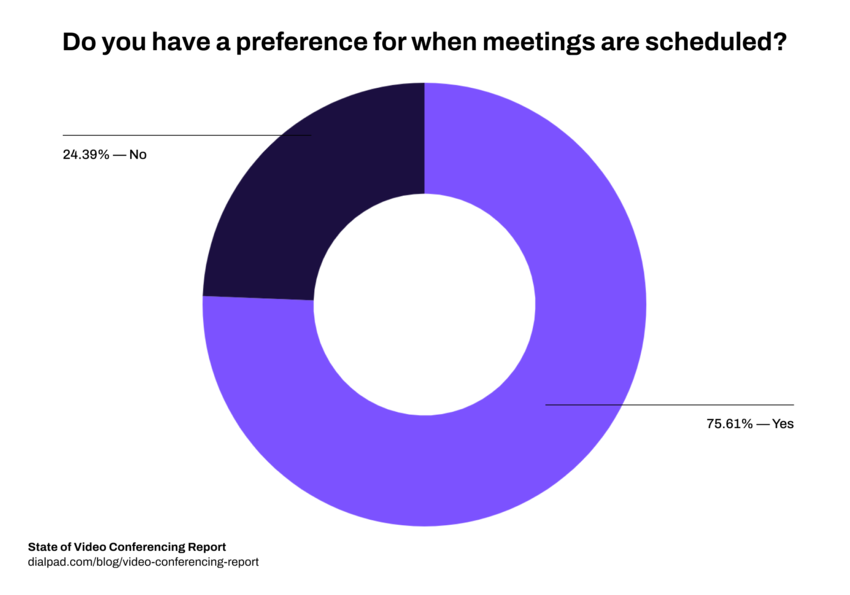
Monday is the most popular day for scheduling meetings (whether it’s to hit the ground running on a new week or get it out of the way sooner than later), with the rest of the week remaining consistent until Friday. Friday, as one can imagine, has slightly fewer meetings on average, whether due to it being a common day to take off with vacation days or because no one wants to spend their last hour before the weekend in a meeting:
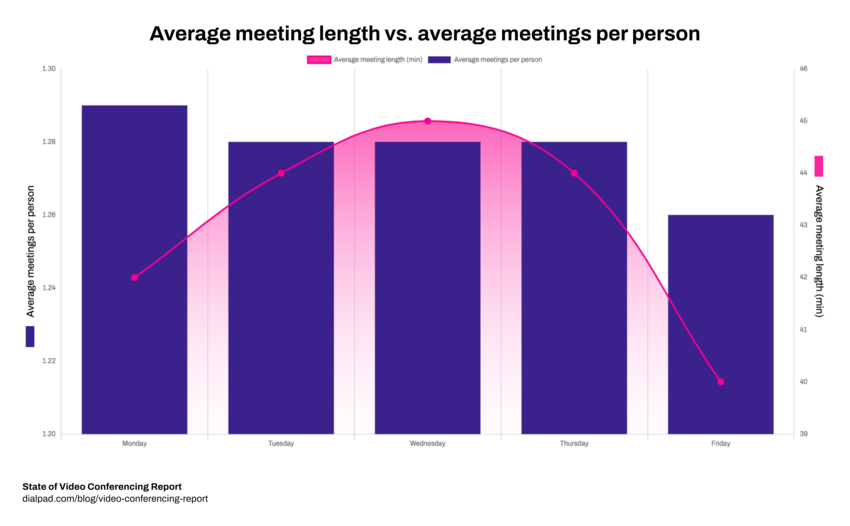
As for how long meetings go for? The average time a meeting takes goes in an upward curve, peaking on Wednesdays with an average of 45 minutes per meeting. As with the days the meetings are held on, those remain fairly steady until Friday, at which point they drop to an average of 40 minutes.
Another interesting note: The size of a meeting correlates with a difference in how long it is. While meetings with three to six participants tend to last a little over 30 minutes, meetings with more people typically go longer. In fact, meetings with 20+ people frequently last over 70 minutes! (On one hand, it’s good to give everyone a chance to talk, but on the other hand, that’s really time-consuming.)

Most-wanted video conferencing features
As much as web conferencing has improved and grown, well, nothing is perfect. There’s still plenty of issues and complaints that can be addressed.
When asked about their pain points, the biggest issues respondents reported were audio-related, such as background noise, mic echo, or forgetting to mute and unmute, with over half the respondents including that as a problem:

Shockingly, only about a quarter said that “too many meetings” was a problem (which doesn't quite line up with what people complain about on social media, anecdotally at least), and the top reason a meeting was considered unpleasant is due to it being unhelpful and time-consuming, with nearly a third of all respondents citing that as an issue.
On top of that, the video conferencing platforms that folks are using seem to be lacking a bit in terms of features. In fact, 27.52% of survey respondents said their video conferencing tool doesn’t meet all their needs.
So what features are they missing? The top four are:
1. The ability to integrate with other tools
2. The ability to join and launch meetings without downloading any new video conference software for small business
3. The ability to meet on any device
4. Real-time transcriptions
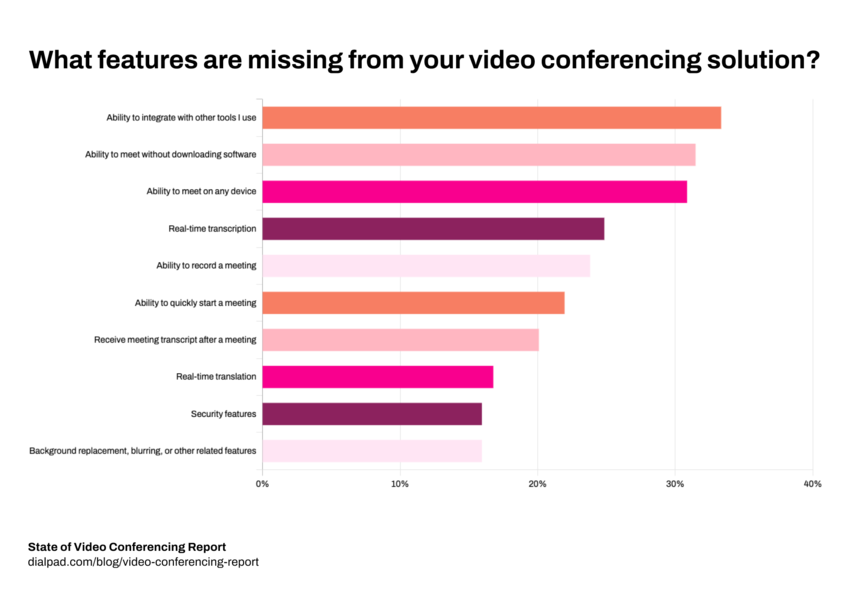
🔌 Shameless plug: It sounds like they could really use a solution that has Dialpad’s expansive integration library, which includes many of the top CRM platforms and APIs to help create new integrations.
Or a solution that’s accessible across devices and web browsers (like Dialpad is), so that everyone can make calls on their phone, computer, or any web browser, and join calls over the internet just by clicking a link—no downloads required.
They might also benefit from a platform that includes something like Dialpad AI, which can transcribe conversations in real time and has analyzed more than one billion minutes of voice.
(Is anyone else noticing a pattern here?)
Other video conferencing fun facts
Top 3 causes of unpleasant meetings
As mentioned earlier, respondents were asked to recall a video conference that they didn’t enjoy. The top 3 reasons were:
Unhelpful meetings that feel like a waste of time (32.7%)
Meetings without progress or a conclusion (24.5%)
Meetings that drifted away from its original agenda, purpose, or goal (28.59%)
Taking the reverse of this, video conferences are more productive (and pleasant) when:
Each attendee benefits from it (attendees learned something, got clarity, etc.)
There is a clear goal or purpose for the meeting, and it’s met
Conversations outside of the scope of the meeting are discussed at another time
Audio calls can be an alternative to video conferencing
Although video conferencing typically involves the use of, well, video, 82.9% of respondents believe that not every meeting requires video. 44.94% believe that any meeting that doesn’t require screen sharing can be done as an audio call instead of a video meeting.
A study from Stanford on video conferencing fatigue found that excessive eye contact feels intense and the cognitive load is higher compared to in-person, face-to-face conversations. Another study from the University of Georgia found that turning off your camera during meetings can help lessen exhaustion.
One solution: Encourage “walking meetings” for certain types of meetings where you can dial-in.
Be mindful of how you name your meetings
Our own Dialpad Meetings data revealed plenty of interesting tidbits about meeting types, including common themes and patterns.
For instance, how many of your meetings are marked as “huddles?” Those are typically short meetings between small groups—about 10 people or fewer and taking 13 minutes or less. Once you start going above 10 people, though, the time they tend to take shoots all the way up to 34 minutes:

However, if you have a group of seven to 10 people and the meeting is called a “team meeting” instead of a “huddle,” you can expect it to go on for over an hour:
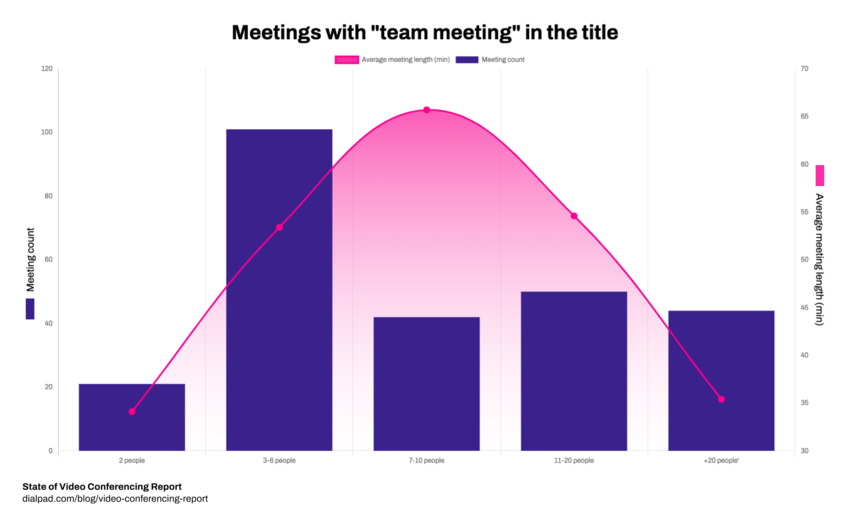
So what meetings tend to go on the longest? “Weekly” meetings with 20 people or more are the longest on average, going for 102 minutes! (Fortunately, weekly meetings typically involve groups of three to six people, so those 20+ attendee meetings are rare.)
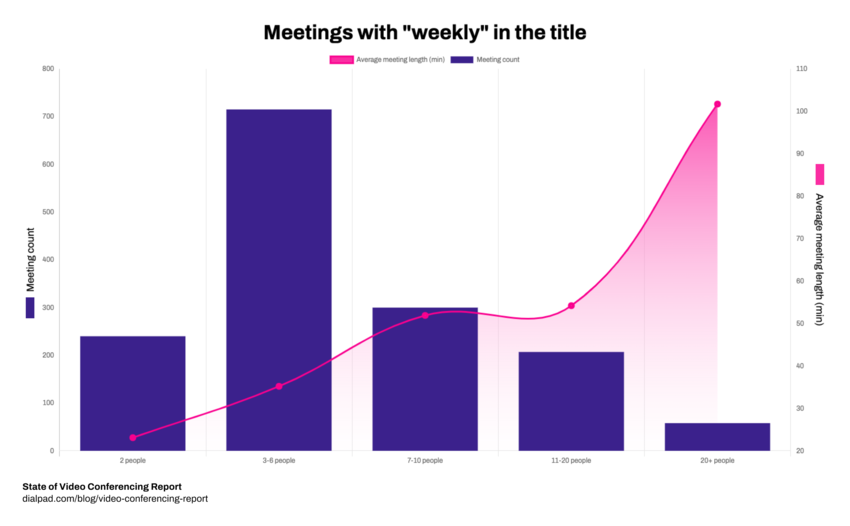
Then which ones are the most time-effective? “Stand-ups” are one of the most time-effective meetings under 20 people, as they tend to finish in 13 minutes or less:
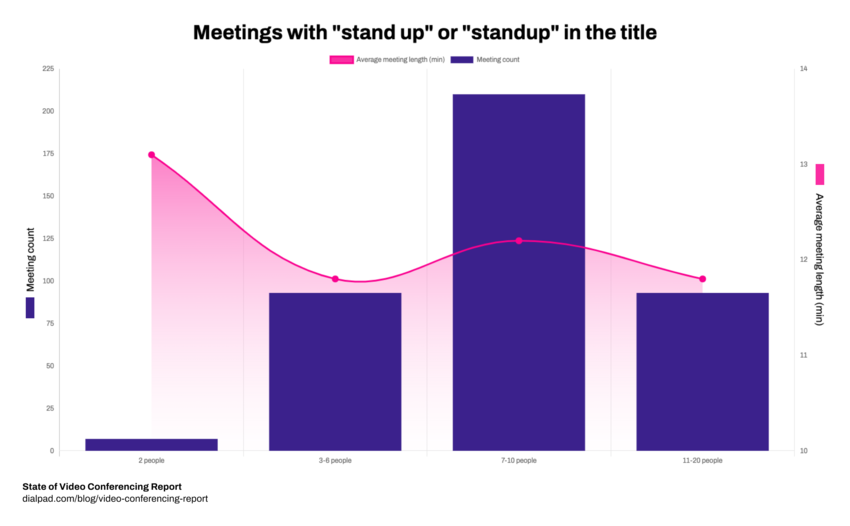
Where do we go from here?
Now then, one question remains: what’s next? We have all this data, so what do we do with it?
Well, we can start by working on being more intentional about scheduling meetings and doing our best to make sure that the ones we have are actually productive—more efficient meetings means fewer meetings overall, which tends to lead to happier employees.
And if you aren't doing so already, try having "no-meeting days!" We do it here at Dialpad, and we've found that it gives our team time to do interruption-free, focused work. (And may even reduce fatigue.)
Of course, to achieve all this, it helps to use a video conferencing solution that actually has features addressing these needs. That includes a variety of integrations, the ability to access calls from anywhere (with or without downloading new software), and real-time transcriptions.
Methodology
For this report, we used two data sources.
We first analyzed data from over 12 million minutes and almost 400,000 meetings held on Dialpad Meetings from 1/1/2019 to 6/30/2021 to identify trends, frequency, and changes in video conferencing behavior before and after the pandemic. All the charts with a dotted vertical line indicate the start of the pandemic. To reduce bias, we did not include video conferences that the Dialpad team held.
We have exciting new features planned for 2022, which will address even more advanced video conferencing use cases such as company all-hands, virtual events, and training. We’ll have even more data to share in our next report!
In November 2021, we also surveyed 2,821 U.S. based employees across various industries, business sizes, departments, and levels about their experience and thoughts on video conferencing. To get a more comprehensive view of the video conferencing landscape, survey respondents include those who use Dialpad Meetings, Zoom, Microsoft Teams, and other video conferencing software.
Thank you to Mahsa Azizi and Nathan Zhang for helping us analyze our data, Robert Pleasant for helping write the content, Austen Ezzell and Melissa Egan for designing the charts!
